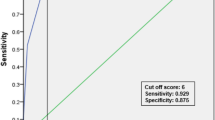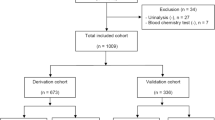Abstract
Most patients with renal colic are discharged from the emergency department (ED) after evaluation and pain alleviation. These patients may not require urgent imaging by computed tomography. We derived a clinical prediction score in patients with renal colic to identify those at very low risk for complications and alternative diagnoses requiring urgent intervention. This retrospective chart review was carried out in 2 ED at an urban university hospital from January to December 2015. All patients with a diagnosis of renal colic were included. The primary outcome was an intervention required for renal colic or alternative diagnoses within 7 days of ED presentation. A stepwise logistic regression was used to assess factors associated with the outcome. A score was derived as a weighted sum of these predictors and its performance was calculated. The database was submitted to the French National Commission for Data Protection and Liberties (CNIL): declaration n°2164898v0 (03/22/2018). 871 with complete data were analyzed. In 94 (11%) patients, an intervention was performed for obstructive urolithiasis or alternative diagnosis. Five factors were most predictive of intervention: age > 45 years (1 point), a history of urologic surgery (1 point), pulse > 100 bpm (1 point), temperature > 37.8 °C (2 point), and urine dipstick negative for blood (1 point), yielding a score of 0–6 points (the Complicated uroLithiasis and Alternative Diagnosis (CLAD) score). The area under the curve of the receiver operating characteristic curve was 0.82 (95% CI 0.77–0.87). We derived a clinical score for renal colic that predicted the presence of obstructive urolithiasis and acute alternative diagnoses requiring intervention.


Similar content being viewed by others
References
Romero V, Akpinar H, Assimos DG (2010) Kidney stones: a global picture of prevalence, incidence, and associated risk factors. Rev Urol. 12:86–96
Fwu C-W, Eggers PW, Kimmel PL, Kusek JW, Kirkali Z (2013) Emergency department visits, use of imaging, and drugs for urolithiasis have increased in the United States. Kidney Int 83:479–486
Metzler IS, Smith-Bindman R, Moghadassi M, Wang RC, Stoller ML, Chi T (2017) Emergency department imaging modality effect on surgical management of nephrolithiasis: a multicenter, randomized clinical trial. J Urol 197:710–714
Assimos D, Krambeck A, Miller NL, Monga M, Murad MH, Nelson CP et al (2016) Surgical management of stones: american urological association/endourological society guideline. PART I. J Urol. 196:1153–1160
Türk C, Petřík A, Sarica K, Seitz C, Skolarikos A, Straub M et al (2016) EAU guidelines on diagnosis and conservative management of urolithiasis. Eur Urol 69:468–474
Moore CL, Carpenter CR, Heilbrun ME, Klauer K, Krambeck AC, Moreno C et al (2019) Imaging in suspected renal colic: systematic review of the literature and multispecialty consensus. J Am Coll Radiol. 16:1132–1143
Moore CL, Bomann S, Daniels B, Luty S, Molinaro A, Singh D et al (2014) Derivation and validation of a clinical prediction rule for uncomplicated ureteral stone–the STONE score: retrospective and prospective observational cohort studies. BMJ 348:g2191
Daniels B, Gross CP, Molinaro A, Singh D, Luty S, Jessey R et al (2016) STONE PLUS: evaluation of emergency department patients with suspected renal colic, using a clinical prediction tool combined with point-of-care limited ultrasonography. Ann Emerg Med 67:439–448
Fukuhara H, Kobayashi T, Takai S, Tawara T, Kikuta M, Sugiura A, et al (2019) External validation of the CHOKAI score for the prediction of ureteral stones: a multicenter prospective observational study. Am J Emerg Med. https://doi.org/10.1016/j.ajem.2019.07.018
Green SM, Schriger DL (2016) The sinking STONE: what a failed validation can teach us about clinical decision rules. Ann Emerg Med 67:433–436
Papa L, Stiell IG, Wells GA, Ball I, Battram E, Mahoney JE (2005) Predicting intervention in renal colic patients after emergency department evaluation. CJEM. 7:78–86
Crozier J, Dean T, Klim S, Kelly A-M (2015) Predictors of admission for patients presenting to the emergency department with renal colic. Emerg Med Australas. 27:86–87
Dean T, Crozier J, Klim S, Kelly A-M (2016) Failed validation of risk prediction model for intervention in renal colic patients after emergency department evaluation. ANZ J Surg 86:930–933
Walls R, Hockberger R, Gausche-Hill M (2017) Rosen’s emergency medicine: concepts and clinical practice, 9th edn. Elsevier, Philadelphia
Türk C, Petřík A, Sarica K, Seitz C, Skolarikos A, Straub M et al (2016) EAU guidelines on interventional treatment for urolithiasis. Eur Urol 69:475–482
Storm-Versloot MN, Verweij L, Lucas C, Ludikhuize J, Goslings JC, Legemate DA et al (2014) Clinical relevance of routinely measured vital signs in hospitalized patients: a systematic review. J Nurs Scholarsh 46:39–49
Levey AS, de Jong PE, Coresh J, El Nahas M, Astor BC, Matsushita K et al (2011) The definition, classification, and prognosis of chronic kidney disease: a KDIGO Controversies Conference report. Kidney Int 80:17–28
van der Does Y, Rood PPM, Ramakers C, Schuit SCE, Patka P, van Gorp ECM et al (2018) Identifying patients with bacterial infections using a combination of C-reactive protein, procalcitonin, TRAIL, and IP-10 in the emergency department: a prospective observational cohort study. Clin Microbiol Infect 24:1297–1304
Mefford JM, Tungate RM, Amini L, Suh D, Anderson CL, Rudkin SE et al (2017) A comparison of urolithiasis in the presence and absence of microscopic hematuria in the emergency department. West J Emerg Med. 18:775–779
Wang RC, Rodriguez RM, Moghadassi M, Noble V, Bailitz J, Mallin M et al (2016) External Validation of the STONE Score, a Clinical Prediction Rule for Ureteral Stone: an Observational Multi-institutional Study. Ann Emerg Med 67:423–432
Fukuhara H, Ichiyanagi O, Midorikawa S, Kakizaki H, Kaneko H, Tsuchiya N (2017) Internal validation of a scoring system to evaluate the probability of ureteral stones: the CHOKAI score. Am J Emerg Med 35:1859–1866
Ferraro PM, Arrabal-Polo MÁ, Capasso G, Croppi E, Cupisti A, Ernandez T et al (2019) A preliminary survey of practice patterns across several European kidney stone centers and a call for action in developing shared practice. Urolithiasis. 47:219–224
Schoenfeld D, Mohn L, Agalliu I, Stern JM (2019) Disparities in care among patients presenting to the emergency department for urinary stone disease. Urolithiasis. https://doi.org/10.1007/s00240-019-01136-y
Meltzer AC, Burrows PK, Kirkali Z, Hollander JE, Kurz M, Mufarrij P et al (2020) Accuracy of patient reported stone passage for patients with acute renal colic treated in the emergency department. Urology. 136:70–74
Kim B, Kim K, Kim J, Jo YH, Lee JH, Hwang JE et al (2016) External validation of the STONE score and derivation of the modified STONE score. Am J Emerg Med 34:1567–1572
Mirfazaelian H, Doosti-Irani A, Jalili M, Thiruganasambandamoorthy V (2020) Application of decision rules on diagnosis and prognosis of renal colic: a systematic review and meta-analysis. Eur J Emerg Med. 27:87–93
Blecher G, Meek R, Egerton-Warburton D, McCahy P, Bach C, Boulos D (2016) Predictors for urologic intervention and alternate diagnoses in people having computed tomography urography for suspected renal colic. Emerg Med Australas. 28:56–61
Fukuhara H, Ichiyanagi O, Kakizaki H, Naito S, Tsuchiya N (2016) Clinical relevance of seasonal changes in the prevalence of ureterolithiasis in the diagnosis of renal colic. Urolithiasis. 44:529–537
Eray O, Cubuk MS, Oktay C, Yilmaz S, Cete Y, Ersoy FF (2003) The efficacy of urinalysis, plain films, and spiral CT in ED patients with suspected renal coli. Am J Emerg Med 21:152–154
Westphalen AC, Hsia RY, Maselli JH, Wang R, Gonzales R (2011) Radiological imaging of patients with suspected urinary tract stones: national trends, diagnoses, and predictors. Acad Emerg Med 18:699–707
Coursey CA, Casalino DD, Remer EM, Arellano RS, Bishoff JT, Dighe M et al (2012) ACR appropriateness criteria® acute onset flank pain–suspicion of stone disease. Ultrasound Q. 28:227–233
Leo MM, Langlois BK, Pare JR, Mitchell P, Linden J, Nelson KP et al (2017) Ultrasound vs. computed tomography for severity of hydronephrosis and its importance in renal colic. West J Emerg Med. 18:559–568
Pathan SA, Mitra B, Mirza S, Momin U, Ahmed Z, Andraous LG et al (2018) Emergency physician interpretation of point-of-care ultrasound for identifying and grading of hydronephrosis in renal colic compared with consensus interpretation by emergency radiologists. Acad Emerg Med 25:1129–1137
Wong C, Teitge B, Ross M, Young P, Robertson HL, Lang E (2018) The accuracy and prognostic value of point-of-care ultrasound for nephrolithiasis in the emergency department: a systematic review and meta-analysis. Acad Emerg Med 25:684–698
Smith-Bindman R, Aubin C, Bailitz J, Bengiamin RN, Camargo CA, Corbo J et al (2014) Ultrasonography versus computed tomography for suspected nephrolithiasis. N Engl J Med 371:1100–1110
Acknowledgements
The authors thank Dr. Azema Olivier for his help with file extraction. The authors thank Dr. Caubet-Kamar Natacha for providing critical revision of the manuscript.
Funding
This work did not require financial support.
Author information
Authors and Affiliations
Contributions
FB designed the study, contributed to the acquisition of the database, performed statistical analysis and interpretation of the data, and drafted the manuscript. MB realized the acquisition of the database. SC, XG and CHHC provided critical revision of the manuscript. DL helped to the interpretation of the data and drafted the manuscript.
Corresponding author
Ethics declarations
Conflict of interest
Authors report no conflicts of interest.
Ethical approval
The database was submitted to the French National Commission for Data Protection and Liberties (CNIL): declaration n°2164898v0 (03/22/2018).
Code availability
Data were analyzed with Stata software (version 13; StataCorp, College Station, TX).
Additional information
Publisher's Note
Springer Nature remains neutral with regard to jurisdictional claims in published maps and institutional affiliations.
Electronic supplementary material
Below is the link to the electronic supplementary material.
Rights and permissions
About this article
Cite this article
Balen, F., Bastouil, M., Charpentier, S. et al. Derivation of a clinical predicting rule for obstructive urolithiasis and alternative diagnosis requiring urgent intervention: the CLAD score. Urolithiasis 49, 145–152 (2021). https://doi.org/10.1007/s00240-020-01191-w
Received:
Accepted:
Published:
Issue Date:
DOI: https://doi.org/10.1007/s00240-020-01191-w




